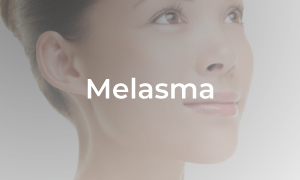Melasma and Skin Pigmentation
Q-switched Nd-YAG Laser Treatment of Melasma
- Before
- After
Melasma is one of the commonest skin pigmentation disorders in Asian population. The causes of melasma are complex and are related to genetic predisposition, hormonal effects, pregnancy, hypothyroidism and photo-damage caused by sunlight exposure. Due to the high prevalence of melasma among Asian people, there are many studies on the aetiology and treatments of melasma. Melasma typically occurs in middle-aged Asian women on areas exposed to sunlight, such as the cheeks, nose, forehead, upper lip, and the chin. Melasma usually starts as small, irregular brownish spots that gradually enlarge and merge to form brownish patches on the face. Because melasma usually occurs on the prominent locations in the face, the lesions are easily noticeable, especially in fair-skinned people.
Management of Melasma
Treatments of melasma may take weeks or even months before the desired results are achieved, especially for severe and chronic cases. Generally, a combination of measures is required for the treatment to be effective:
-
-
-
UV and Sunlight Protection. Protection from sunlight and UV light (ultra-violet) is essential, especially in tropical countries like Malaysia because of the intense sunlight and chronic UV exposure. The daily use of good-quality sunscreen gel/cream with SPF 50 or above is crucial for adequate protection. The patients are also encouraged to use physical UV barriers such as a UV-proof umbrella, hat, and clothing when going outdoors. UV screen for car and home windows are helpful. Continuing sunlight and UV protection are essential to prevent the recurrence of melasma.
-
Topical Agents. There are a variety of products that can lighten and bleach the skin pigmentation in melasma. These products are applied to the affected areas to speed up natural cell turnover and block melanin production which causes skin pigmentation in melasma.
-
Laser therapy: Q-Switched Nd-YAG Laser System (Medlite™). Q-switched Nd-YAG laser is the gold standard for the treatment of melasma. The laser delivers high-energy pulses in nano-seconds to selectively break down the melasma pigments without damaging the surrounding tissues. Treatment is performed every 1-2 weeks for a total of 6 sessions. Downtime is minimal, and the patient can go back to work immediately after treatment.
-
-
Procedure
Laser System: Q-Switched Nd-YAG Laser (Medlite™)
Duration: 20 to 30 minutes for each session
Anaesthesia: Usually not required. Numb cream is used for patients who have sensitive skin.
Downtime: 1-2 hours
Total sessions required: 6 sessions or more.
The interval between sessions: 1 to 2 weeks
Post Laser Care
What to Expect: Mild skin redness 1-2 hours
Skincare protocol:
-
-
-
Clean the face in the morning and at night with a gentle cleanser.
-
Use a high-grade moisturiser to restore moisture in the skin. Adequate hydration of the skin is essential to keep the skin healthy and protect it from damage.
-
Apply sunscreen at least twice a day, once in the morning and once in the afternoon. In the events the sunscreen wears off due to sweating, face-washing, or swimming, it is important to reapply the sunscreen to ensure continuing protection.
-
-
Use physical sun protection such as an anti-UV umbrella and hat while going out under the sunlight.
Continuing sun protection is crucial to maintain satisfactory results and prevent the recurrence of melasma.










